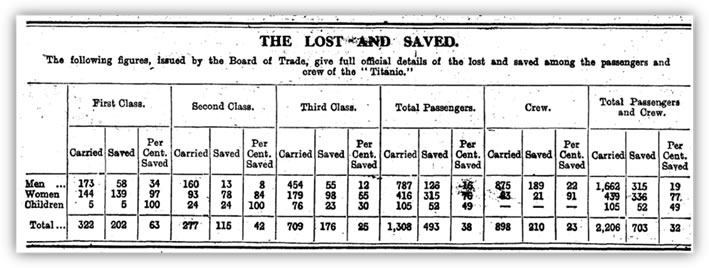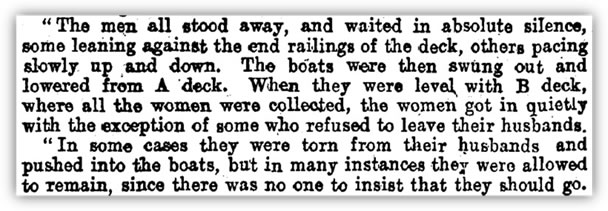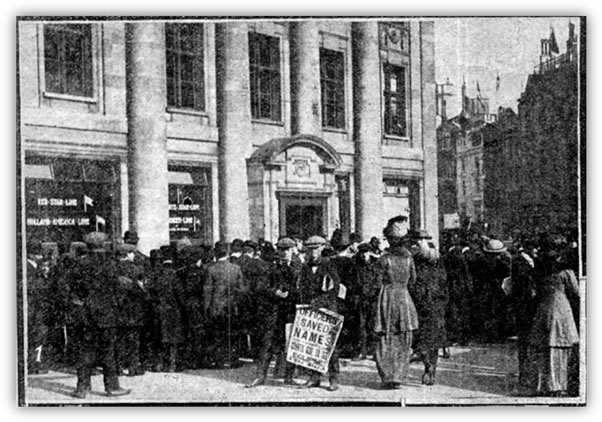On the 15th of April 2012, we mark 100th anniversary of the sinking of the Titanic. This is a story of what happened to three very different people and how they found the odds stacked against them and the very different ways they dealt with the tragedy.
The Titanic was the largest ship afloat at the time of her maiden voyage in 1912. It set sail from Southampton heading first for Cherbourg, Queenstown (Cork) then her fatal leg to New York, carrying over 2200 people, with 1316 passengers and around 900 crew. As well as the wealthy and famous, such as John Jacob Astor IV, Isidor Straus and Benjamin Guggenheim, there were working class people who had given up everything to start a new life in America.
Over 1,500 people are recorded to have died in the disaster, but figures vary slightly as some later deaths were caused by the event.

Climbing to Freedom
Margaret Devaneywas a 19 year old Irish girl from County Sligo travelling to New York in third class with her two friends Mary Burns and Kate Hargadon. Margaret had a brother and two sisters already living in New York, and the girls were emigrating together to join them and start a new life in America.
They had been alerted during the night by a male passenger that something was happening and went out on the deck to investigate. Hearing the activity on the upper deck, they went back to their cabin to grab their life jackets and tried to make their way up to the lifeboats. They were horrified to discover that their passage was blocked as the gates to second class deck were locked .
Undeterred, the girls found a ladder and climbed from the Aft Well deck up to second class. One of the friends began to feel unwell and couldn’t go any further, so the other stayed with her whilst Margaret went in search of a boat, intending to return for her two friends later.

As she was searching the deck for a boat, Margaret found herself trapped in the crowds and was pushed into Collapsible C, which then became caught on the ship’s rivets as it was lowered into the sea. Margaret had a pen knife in her pocket that her younger brother had given her before she boarded the Titanic. She handed the knife over to the crew to cut the ropes, saving the lives of all the passengers in Collapsible C.
Sadly Margaret never saw her two friends again as Mary and Catherine died in the sinking. Margaret started a new life in New York and married John Joseph O’Neill in 1919. She moved to New Jersey where she had six children with John, and lived a long life until June 12, 1974 when she passed away at the age of 82.

Looking out for Fred
Ernest Allen was a 24 year old from Southampton, originally born in London, who usually worked as a fireman but was employed on the Titanic as a trimmer in the engine room. His job was to make sure that coal was taken from the right place to ensure the ship didn’t become unbalanced. Ernest also took with him his younger brother Fred, who was just 17 years old, and on his first voyage, employed as a lift steward.
As the Titanic began to sink, Ernest felt obliged to keep looking for his brother, how could he return home without him, what would his mother say. His search grew more desperately but finally he had to turn back. After failing to find Fred, Ernest had returned to the boat deck and found his designated boat had already left. He helped to cut loose Collapsible B which dropped into the sea upside down, and managed to climb onto the over turned boat along with around 30 other men. They were later rescued by boats 4 and 12. Sadly he never found his younger brother, who perished along with all the Titanic’s lift stewards, and his body was never recovered. A death notice appeared for Fred in the Daily Echo on the 24th April, and their mother Sophia received a grant of £20 from the Mansion House Titanic Relief Fund. Ernest returned to his family in Southampton and spent most of his life there. He died in 1968 at the age of 80.
Access Over a Billion Records
Try a four-month Diamond subscription and we’ll apply a lifetime discount making it just £44.95 (standard price £64.95). You’ll gain access to all of our exclusive record collections and unique search tools (Along with Censuses, BMDs, Wills and more), providing you with the best resources online to discover your family history story.
We’ll also give you a free 12-month subscription to Discover Your Ancestors online magazine (worth £24.99), so you can read more great Family History research articles like this!

The Silver Prince
One of Titanic’s most famous passengers, Benjamin Guggenheim,was born in 1865 in Philadelphia, the fifth of seven sons born to the wealthy mining magnate Meyer Guggenheim. He married Florette Seligman in 1894 and they had three daughters, Benita, Peggy and Barbara.
He was nicknamed the ‘Silver Prince’ for his involvement and interest in the family business and was originally booked to travel back to America in 1912 onboard the Lusitania. The voyage was cancelled as the ship needed to undergo repairs and Guggenheim booked a passage on the maiden voyage of the Titanic instead. He was travelling with his valet Victor Giglio, his chauffeur, and his mistress, French singer Madame Aubart, who was accompanied by her maid.

On the evening of the disaster, Guggenheim had initially been dressed in warm clothing and a life jacket by a steward, but as the reality of the situation began to close in, he decided to return to his cabin and change into his best evening clothes. According to witness reports, he said ‘We’re dressed up in our best and are prepared to go down like gentlemen’. He also assisted in helping women and children into lifeboats and asked a steward to pass a message onto his wife should he not survive:
'“Tell her I played the game out straight and to the end. No woman was left on board this ship because Ben Guggenheim was a coward. Tell her that my last thoughts will be of her and our girls, but that my duty now is to these unfortunate women and children on this ship. Tell her I will meet whatever fate is in store for me, knowing she will approve of what I do .”
In his will, after making donations to charity, Benjamin Guggenheim left a third of his estate to his wife Florette, who is shown in the photo below, and the remaining two thirds to his girls, who were 17, 14 and 9 years of age.

A supplement by Lloyds weekly newspaper titled 'The Deathless Story of the Titaniccontains first-hand accounts from passengers witnessing the tragedy, and describes moving scenes of couples saying goodbye, with some believing that their husband would follow on another boat, and others who were aware that they may not see their husband again. There are accounts of women who refused to leave their husbands behind, and had to be placed into the life boat by force.
This supplement is now available to view on TheGenealogist.co.uk as part of the new Titanic collection, and contains pictures and tributes as well as witness statements and a list of survivors.
Also included in our new Titanic collection are ‘The Sinking of the Titanic’ and our new Titanic database.







